Browse All Articles > Recreating a missing free/busy folder on Exchange 2010
If you are in the following situation:
![Check in PF Management Console]() I will take a step back to explain shortly how Outlook 2003 is behaving regarding Free/Busy.
I will take a step back to explain shortly how Outlook 2003 is behaving regarding Free/Busy.
Ol2003 is looking for the user’s legacyExchangeDN and expect to find a system public folder with that same name. To find that folder it looks for an administrative group and a “siteFolderServer” attribute pointing to a public folder database. Migrated ex2003 users are still holding the old legacyExchangeDN.
Outlook 2007 and 2010 are not affected because they are not using public folders for free/busy. They are relaying to the exchange availability service on Ex2010.
Now, looking at the event ID 14031 we see - Unable to find freebusy public folder: “My Missing Admin Group” for a specific user. If we check that user in ADSI edit:
![Old user legacyExchangeDN]()
We see that the migrated user “al” still has “My Missing Admin Group” in his legacyExchangeDN
When you removed the ex2003 you probably didn’t replicate the system public folders and completely deleted the legacy administrative group. Now in your Ex2010 PF database there is no such system folder and we are unable to recreate it simply through power shell.
rosoft Exchange>YourOrgName> Administrative Groups> Right click and select to create a new admin group
In my example the name is “My Missing Admin Group” (you are probably missing First Administrative Group)
![Create a new Administrative Group]()
Properties of the newly created group and set the legacyExchangeDN as /o=YourOrgName/ou=Your Missing Group
![Set the legacyExchangeDN of the new Admin Group]()
Now we need to point the “siteFolderServer” attribute to the ex2010 public folder database. For this copy the “distinguishedName” attribute of the PF database to the “siteFolderServer” attribute of the administrative group
![Copy the distinguishedName attribute of the PF database to the siteFolderServer]()
We are almost done. We need to set this last attribute called “siteFolderGUID”
![Empty siteFolderGUID]()
In order to generate the above download this small tool from Microsoft's Website
Run the tool and select registry format. Copy the result in a notepad.
Remove all brackets and hyphens from the GUID and add a space between every two characters
![Generate the siteFolderGUID]()
Now paste the formatted result into the “siteFolderGUID”
![Formatted result into the siteFolderGUID]()
After a dismount/mount of the public folder database, we can see that our missing free/busy folder is correctly recreated and listed in the PF management console
![Free Busy folder is correctly recreated]()
If you are still missing the free/busy folder double check the following attributes in the newly created administrative group
- legacyExchangeDN
- siteFolderServer
- siteFolderGUID
Finally in conclusion, if our migrated users are still using Outlook 2003 we should not delete the legacy administrative group even when Exchange 2003 is fully removed. If your old administrative group exists but the free/busy system folder is not created, then most probably your “siteFolderServer” attribute is not pointing to the Ex2010 PF database.
You have recently migrated from Exchange 2003 to Exchange 2010
You have completely uninstalled and decommissioned your old Ex2003
Your users are starting to report issues regarding Free/Busy when scheduling appointments.
You find out that only Outlook 2003 users are experiencing the problem but not OL2007 and OL2010
You notice the error event ID 14031 similar to the following:
Log Name: Application
Source: MSExchangeMailboxAssistants
Event ID: 14031
Task Category: FreeBusy Assistant
Level: Error
Keywords: Classic
User: N/A
Computer: XXXXX
Description:
Unable to find freebusy public folder: EX:/o=OrgName/ou=My Missing Admin Group on the server: XXXXX for the user: User Name: XXXXX with legacy DN: /o=First Organization/ou=First Administrative Group/cn=Recipients/cn=username
Now if we open EMC>Toolbox>Public Folder Management Comsole> “System Public Folders”> “SCHEDULE+FREE BUSY” … You noticed that indeed the “My Missing Admin Group” is not listed
Log Name: Application
Source: MSExchangeMailboxAssistant
Event ID: 14031
Task Category: FreeBusy Assistant
Level: Error
Keywords: Classic
User: N/A
Computer: XXXXX
Description:
Unable to find freebusy public folder: EX:/o=OrgName/ou=My Missing Admin Group on the server: XXXXX for the user: User Name: XXXXX with legacy DN: /o=First Organization/ou=First Administrative Group/cn=Recipients/cn=use
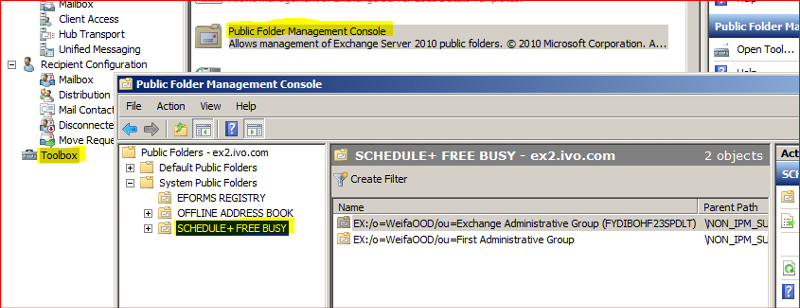 I will take a step back to explain shortly how Outlook 2003 is behaving regarding Free/Busy.
I will take a step back to explain shortly how Outlook 2003 is behaving regarding Free/Busy.
Ol2003 is looking for the user’s legacyExchangeDN and expect to find a system public folder with that same name. To find that folder it looks for an administrative group and a “siteFolderServer” attribute pointing to a public folder database. Migrated ex2003 users are still holding the old legacyExchangeDN.
Outlook 2007 and 2010 are not affected because they are not using public folders for free/busy. They are relaying to the exchange availability service on Ex2010.
Now, looking at the event ID 14031 we see - Unable to find freebusy public folder: “My Missing Admin Group” for a specific user. If we check that user in ADSI edit:
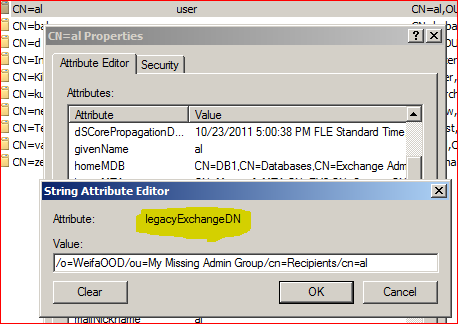
We see that the migrated user “al” still has “My Missing Admin Group” in his legacyExchangeDN
When you removed the ex2003 you probably didn’t replicate the system public folders and completely deleted the legacy administrative group. Now in your Ex2010 PF database there is no such system folder and we are unable to recreate it simply through power shell.
Here are the steps to recreate this missing free/busy folder (in my case called “My Missing Admin Group”)
With ADSI edit navigate to Configuration>Services>MicIn my example the name is “My Missing Admin Group” (you are probably missing First Administrative Group)
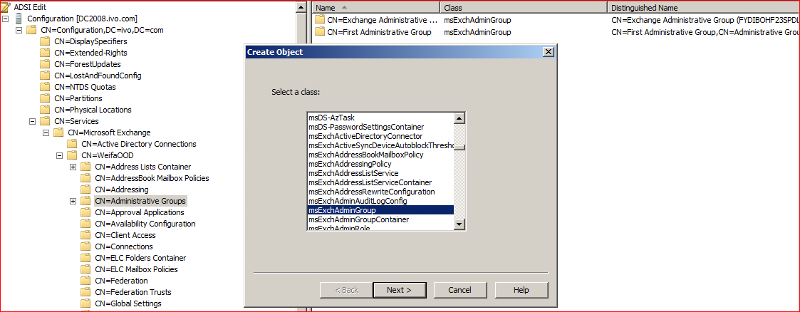
Properties of the newly created group and set the legacyExchangeDN as /o=YourOrgName/ou=Your Missing Group

Now we need to point the “siteFolderServer” attribute to the ex2010 public folder database. For this copy the “distinguishedName” attribute of the PF database to the “siteFolderServer” attribute of the administrative group
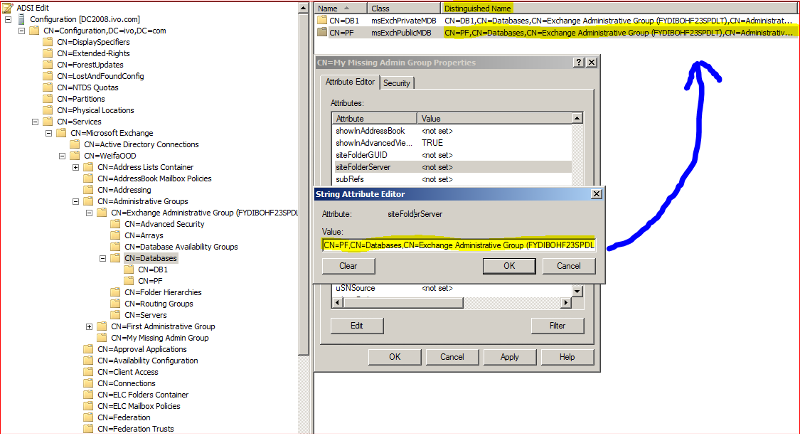
We are almost done. We need to set this last attribute called “siteFolderGUID”
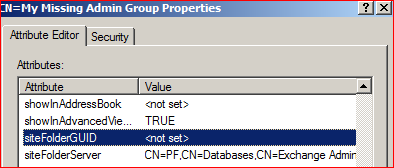
In order to generate the above download this small tool from Microsoft's Website
Run the tool and select registry format. Copy the result in a notepad.
Remove all brackets and hyphens from the GUID and add a space between every two characters
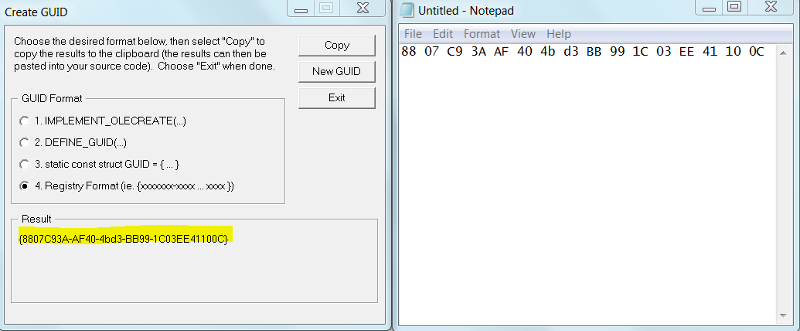
Now paste the formatted result into the “siteFolderGUID”
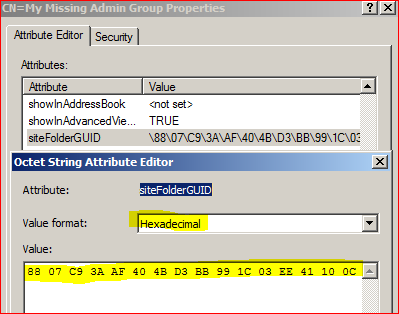
After a dismount/mount of the public folder database, we can see that our missing free/busy folder is correctly recreated and listed in the PF management console

If you are still missing the free/busy folder double check the following attributes in the newly created administrative group
- legacyExchangeDN
- siteFolderServer
- siteFolderGUID
Finally in conclusion, if our migrated users are still using Outlook 2003 we should not delete the legacy administrative group even when Exchange 2003 is fully removed. If your old administrative group exists but the free/busy system folder is not created, then most probably your “siteFolderServer” attribute is not pointing to the Ex2010 PF database.
Have a question about something in this article? You can receive help directly from the article author. Sign up for a free trial to get started.


Comments (3)
Commented:
Commented:
Commented: